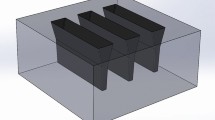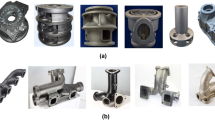Abstract
Production of ductile iron has been linked to the use of Mg and Mg-alloys since its invention. In the early history of ductile iron production, pure or high Mg containing alloys were needed due to the higher S level in the base iron.
With the introduction of basic slag cupolas and low S base iron, the high Mg containing alloys were replaced with materials with lower Mg-content providing a calmer reaction with less slag generation and more predictable results and tighter control of the final Mg level.
MgFeSi was recognized early as an excellent material to introduce Mg into the cast iron melt. MgFeSi offered the possibility to design both chemical composition and sizing to accommodate needs such as reaction control for different treatment processes, trace element control, packing density, and boosting of Mg-level.
One of the main goals with MgFeSi treatments is to minimize the overall addition of Mg to tight reproducible low levels to reduce the shrinkage tendency observed with high final Mg levels. This can be achieved through a combination of optimization of the MgFeSi composition as well as improvement of the treatment process. A well designed MgFeSi-treatment can reduce fume and flare, slag generation, and the need for subsequent inoculation.
The history and evolution of MgFeSi treatment along with relevant recent case studies will be presented in this paper. Examples of how the MgFeSi material can be optimized will be presented both in terms of theory and case studies. Focus of case studies will be on the recent evolutions focusing on maximizing Mg-yield through delayed and calm reaction.
Similar content being viewed by others
References
Ductile Iron Production Practices, Karsay, S.I., American Foundrymen’s Society, Inc Publication (1985).
Labrecque, C., Gagné, M., “Review Ductile Iron: Fifty Years of Continuous Development” Canadian Metallurgical Quarterly, vol. 37, no. 5 pp. 343–378 (1998).
Millis, K.D., Gagnebin, A.P., Pilling, N.B., “Cast Ferrous Alloy”, US Patent 2,485,760 (1949).
Gußeisen; Piwowarsky, E., Springer-Verlag (1951).
Principles of Metal Casting; Heine, R.W., Loper, C., Rosenthal, P.C., Tata McGraw-Hill Edition 1976, ISBN 0-07-099348-3 (2005).
Heine, H., “An Overview of Magnesium Treatment Processes Which Have Stood the Test of Time in America,” BCIRA Conference — S.G.Iron The next 40 Years, Warwick, UK (1987).
Skaland, T., “Ductile Iron Production — A Comparison of Alternative Treatment Methods,” Metal Casting and Surface Finishing (1999).
Forrest, R.D., Wolfensberger, H., “Improved Ladle Treatment of Ductile Iron by Means of the Tundish Cover,” AFS Transactions, vol. 88, pp. 421–426 (1980).
Elkem presentations
Loper, C.R., Heine, R.W., Wang, C.C., Janowski, L., “Fading of Magnesium Treatment in Ductile Cast Irons,” AFS Transactions, vol. 84, pp. 203–214 (1976).
Dunks, C.M, “Process for Manufacturing of Cast Iron”, U.S. Patent 4,004,630,(1975).
Holden, W.W., Dunks. C.M., “The Practical Application and Economic aspect of the Inmold process in the United States,” British Foundryman, 73–265 (1980).
Elkem Internal Report 24th October, 1994
Hoel, E.G., “Structures and phase relations in silicomanganese alloys” Phd Thesis Met. Inst, NTNU, 1998, MI-report 1998:52
Guichelaar, P.J, Trojan. P.K, McCluhan, T., Flinn, R.A., “A new technique for vapor pressure measurement applied to Fe-Si-Mg system”, Metallurgical and Materials Transaction, vol. 2, no. 2, pp 3305–3313 (1971).
Colour Metallography of Cast Iron, Zhou, J., China Foundry, vol. 7, issue 3 (2010).
Morrogh, H., Williams, W.J., “The Production of Nodular Graphite Structures in Cast Iron” Journal of the Iron and Steel Institute (March 1948).
Hoel, E.G., Elkem Internal Report F173/08 (2008).
Elkem Internal Report STF34 F91045 (February 1991).
Schumacher, W., “Magnesiumvorlegierungen und deren Einbringen in Gußeisenschmelzen zur Herstellung von Gußeisen mit Kugelgraphit“, Technische Mitteilungen, 58 Jahrgang Heft 7
Lalich, M.J., “Effective Use of Rare Earths in Magnesium Treated Ductile Cast Irons,” AFS Transactions, vol. 82, pp. 441–448 (1974).
Amin, A.S., Loper, Jr., C.R., “Cerium and Rare Earths in Ductile Cast Irons,” AFS Transactions, vol. 86, pp. 505–512 (1978).
Henning, W.A., “Commercial Experience with 5% Magnesium Ferrosilicon Alloys Containing Various Rare Earth Sources,” AFS Transactions, vol. 91, pp. 71–76 (1983).
Morrogh, H., “Influence of some Residual Elements and Their Neutralization in Magnesium-Treated Nodular Cast Iron,” AFS Transactions, vol. 60, pp. 439–451 (1952).
Dunks, C.M., “In-The-Mold Worldwide — Today and Tomorrow,” AFS Transactions, vol. 90, pp. 551–556 (1982).
Skaland, T., “A New Method for Chill and Shrinkage Control in Ladle Treated Ductile Iron,” Keith Millis Symposium (2003).
46th Census of World Casting Production, Modern Casting (December 2012).
Author information
Authors and Affiliations
Rights and permissions
About this article
Cite this article
Hartung, C., White, D., Copi, K. et al. The Continuing Evolution of MgFeSi Treatments for Ductile and CG Irons. Inter Metalcast 8, 7–15 (2014). https://doi.org/10.1007/BF03355577
Published:
Issue Date:
DOI: https://doi.org/10.1007/BF03355577




